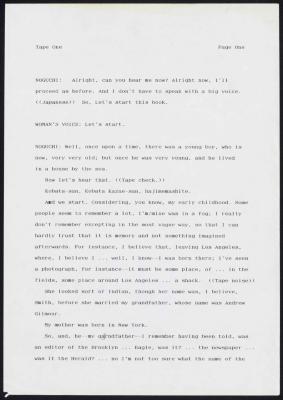Isamu Noguchi interviewed by Kazue Kobata. Part 1 of 13.
August 24 1986
Identifier
AV_CTE_004B_1986_01
Duration
1h 3m 1.0s
Description
Noguchi reads passages about the essence of photography and sculpture - the intimate involvement between the sculptor and the sculpture. Noguchi discusses his writing process - editing - Sam Hunter. Noguchi’s Japanese home - Noguchi’s status in the local community of Mure - Masatoshi Izumi. Noguchi’s sense of isolation - Ailes Gilmour - Leonie Gilmour. Recollections of schooling in Chigasaki. Relationship between foreigners and the Japanese - feelings of not belonging. Noguchi’s childhood home - description of returning to home in 1950’s. Leonie Gilmour’s work for the Far Eastern Review in Tokyo. Noguchi commuting to Yokohama - boarding school. Description of Leonie Gilmour’s character - love of Japanese culture, Irish literature - William Blake - connection between Japanese culture and Irish poetry – relationship with nature and folk myth. Strained relationship with Yone Noguchi - meeting Totaro Takagi in 1931 - Michio Noguchi. Noguchi recalls a San Francisco Examiner article in 1906 that mentions his mother’s departure for Japan - undertones of Yellow Peril. Noguchi discusses mother’s reasons for moving to Japan - origin of Yone Noguchi and Leonie Gilmour’s relationship - Noguchi’s birth in California - Yone Noguchi’s California poetry - University of California at Berkeley. Ikuko Atsumi - mimeograph of Leonie Gilmour’s personal letters - Kazuko Shiraishi - Personal documents related to Noguchi’s parents may be located at Keio University. The Story of Yone Noguchi - Yone Noguchi’s literary reputation in America - Rabindranath Tagore. Leonie Gilmour’s decision to send Noguchi back to America - birth of Ailes Gilmour. Issues of assimilation of the West in Japan - Meiji Era education practices and nationalist policies - Modernism in Japan. Yone Noguchi’s nationalism. Noguchi’s mixed race identity - unstable relationship to Japan and America. Offers to adopt Noguchi by Leonie Gilmour’s pupils. The Interlaken Preparatory School for Boys - closure of the school - transformation into Army camp during World War I - Dr. Edward A. Rumely.
Creator
Collection
